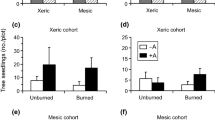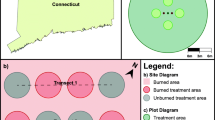Abstract
The intermediate disturbance hypothesis (IDH) predicts that species diversity is maximized at moderate disturbance levels. This model is often applied to grassy ecosystems, where disturbance can be important for maintaining vascular plant composition and diversity. However, effects of disturbance type and frequency on cover and diversity of non-vascular plants comprising biological soil crusts are poorly known, despite their potentially important role in ecosystem function. We established replicated disturbance regimes of different type (fire vs. mowing) and frequency (2, 4, 8 yearly and unburnt) in a high-quality, representative Themeda australis–Poa sieberiana derived grassland in south-eastern Australia. Effects on soil crust bryophytes and lichens (hereafter cryptogams) were measured after 12 years. Consistent with expectations under IDH, cryptogam richness and abundance declined under no disturbance, likely due to competitive exclusion by vascular plants as well as high soil turnover by soil invertebrates beneath thick grass. Disturbance type was also significant, with burning enhancing richness and abundance more than mowing. Contrary to expectations, however, cryptogam richness increased most dramatically under our most frequent and recent (2 year) burning regime, even when changes in abundance were accounted for by rarefaction analysis. Thus, from the perspective of cryptogams, 2-year burning was not an adequately severe disturbance regime to reduce diversity, highlighting the difficulty associated with expression of disturbance gradients in the application of IDH. Indeed, significant correlations with grassland structure suggest that cryptogam abundance and diversity in this relatively mesic (600 mm annual rainfall) grassland is maximised by frequent fires that reduce vegetation and litter cover, providing light, open areas and stable soil surfaces for colonisation. This contrasts with detrimental effects of 2-year burning on native perennial grasses, indicating that this proliferation of cryptogams has potentially high functional significance for situations where vegetation cover is depleted, particularly for reducing soil erosion.



Similar content being viewed by others
References
Anderson M (2005) PERMANOVA: a FORTRAN computer program for permutational multivariate analysis of variance. Users guide. Department of Statistics, University of Auckland, New Zealand
Belnap J (2003) The world at your feet: desert biological soil crusts. Front Ecol Environ 1:181–189
Bergamini A, Pauli D, Peintinger M, Schmid B (2001) Relationships between productivity, number of shoots, and number of species in bryophytes and vascular plants. J Ecol 89:920–929
Billeter R, Peintinger M, Diemer M (2007) Restoration of montane fen meadows by mowing remains possible after 4–35 years of abandonment. Bot Helv 117:1–13
Brodo IM (1961) A study of lichen ecology in central Long Island, New York. Am Midl Nat 65:290–310
Clarke KR, Gorley RN (2006) Primer v6: user manual/tutorial. PRIMER-E, Plymouth
Collins SL, Glenn SM, Gibson DJ (1995) Experimental analysis of intermediate disturbance and initial floristic composition: decoupling cause and effect. Ecology 76:486
Collins SL, Knapp AK, Briggs JM, Blair JM, Steinauer EM (1998) Modulation of diversity by grazing and mowing in native tallgrass prairie. Science 280:745–747
Connell JH (1978) Diversity in tropical rainforests and coral reefs. Science 199:1302–1310
Cuddy WS (2000) The distribution and floristics of non-vascular soil crusts in box woodlands on the inland slopes of New South Wales. Honours thesis, School of Geography, University of New South Wales, Sydney
Dufréne M, Legendre P (1997) Species assemblages and indicator species: the need for a flexible asymmetrical approach. Ecol Monogr 67:345–366
Eldridge DJ (1998) Dynamics of moss- and lichen-dominated soil crusts in a patterned Callitris glaucophylla woodland in eastern Australia. Acta Oecol 20:159–170
Eldridge DJ (2001) Biological soil crusts of Australia. In: Belnap J, Lange O (eds) Biological soil crusts: structure, management and function. Ecological studies 150. Springer, Berlin, pp 119–132
Eldridge DJ, Greene RSB (1994) Microbiotic soil crusts: a review of their roles in soil and ecological processes in the rangelands of Australia. Aust J Soil Res 32:389–415
Eldridge D, Tozer ME (1997) A practical guide to soil lichens and bryophytes of Australia's dry country. Department of Land and Water Conservation, Sydney
Eldridge DJ, Semple WS, Koen TB (2000) Dynamics of cryptogamic soil crusts in a derived grassland in south-eastern Australia. Aust Ecol 25:232–240
Eldridge DJ, Freudenberger D, Koen TB (2006) Diversity and abundance of biological soil crust taxa in relation to fine and coarse-scale disturbances in a grassy eucalypt woodland in eastern Australia. Plant Soil 281:255–268
Esposito A, Mazzoleni S, Strumia S (1999) Post-fire bryophyte dynamics in Mediterranean vegetation. J Veg Sci 10:261–268
GenStat (2007) GenStat, 10th edn. Lawes Agricultural Trust, VSN International, Oxford
Gotelli NJ, Colwell K (2001) Quantifying biodiversity: procedures and pitfalls in the measurement and comparison of species richness. Ecol Lett 4:379–391
Gotelli NJ, Entsminger GL (2006) EcoSim: null models software for ecology. Version 7. Acquired Intelligence, Kesey-Bear, Jericho, VT http://garyentsminger.com/ecosim.htm. Accessed February 2008
Greene RSB, Tongway DJ (1989) The significance of (surface) physical and chemical-properties in determining soil surface condition of red earths in rangelands. Aust J Soil Res 27:213–225
Greene RSB, Chartres CJ, Hodgkinson KC (1990) The effects of fire on the soil in a degraded semi-arid woodland. I. Cryptogam cover and physical and micromorphological properties. Aust J Soil Res 28:755–777
Grime JP (1973) Competitive exclusion in herbaceous vegetation. Nature 242:344–347
Huhta AP, Rautio P, Tuomi J (2001) Restorative mowing on an abandoned semi-natural meadow: short-term and predicted long-term effects. J Veg Sci 12:677–686
Huston M (1979) A general hypothesis of species diversity. Am Nat 113:81–101
Huston M (1994) Biological diversity: the coexistence of species on changing landscapes. Cambridge University Press, New York
Huston MA (2004) Management strategies for plant invasions: manipulating productivity, disturbance, and competition. Div Distr 10:167–178
Isbell RF (1996) The Australian soil classification. CSIRO, Melbourne
Kinnell PIA, Chartres CJ, Watson CL (1990) The effects of fire on the soil in a degraded semiarid woodland. 2. Susceptibility of the soil to erosion by shallow rain-impacted flow. Aust J Soil Res 28:779–794
Kondoh M (2001) Unifying the relationships of species richness to productivity and disturbance. Proc R Soc Lon B Biol Sci 268:269–271
Li J, Loneragan WA, Duggin JA, Grant CD (2004) Issues affecting the measurement of disturbance response patterns in herbaceous vegetation–a test of the intermediate disturbance hypothesis. Plant Ecol 172:11–26
Looman J (1964) Ecology of lichen and bryophyte communities in Saskatchewan. Ecology 45:481–491
Lunt ID (1997) Effects of long-term vegetation management on remnant grassy forests and anthropogenic native grasslands in south-eastern Australia. Biol Conserv 81:287–297
Lunt ID, Morgan JW (2002) The role of fire regimes in temperate lowland grasslands of south-eastern Australia. In: Bradstock R, Williams J, Gill AM (eds) Flammable Australia: the fire regimes and biodiversity of a continent. Cambridge University Press, Cambridge, pp 177–196
Mackey RL, Currie DJ (2001) The diversity-disturbance relationship: is it generally strong and peaked? Ecology 82:3479–3492
McCarthy PM (1991) Checklist of Australian lichens, 4th edn. National Herbarium of Victoria, Melbourne
McCune B, Mefford MJ (1999) PC-ORD. Multivariate analysis of ecological data. Version 4. MjM software design, Gleneden Beach, OR
Meagher D, Fuhrer B (2003) A field guide to the mosses and allied plants of microphytic crust cover: further evidence from a wooded semiarid Australian rangeland. Arid Soil Res Rehab 11:113–126
Mistry J (1998) Corticolous lichens as potential bioindicators of fire history: a study in the cerrado of the distrito federal, central Brazil. J Biogeogr 25:409–441
Moore RM (1973) South-eastern temperate woodlands and grasslands. In: Moore RM (ed) Australian grasslands. Australian National University Press, Canberra, pp 169–190
Morgan JW (1998) Importance of canopy gaps for recruitment of some forbs in Themeda triandra-dominated grasslands in south-eastern Australia. Aust J Bot 46:609–627
Morgan JW (1999) Defining grassland fire events and the response of perennial plants to annual fire in temperate grasslands of south-eastern Australia. Plant Ecol 144:127–144
Morgan JW (2004) Bryophyte composition in a native grassland community subjected to different long-term fire regimes. Cunninghamia 8:485–489
Morgan JW (2006) Bryophyte mats inhibit germination of non-native species in burnt temperate native grassland remnants. Biol Invas 8:159–168
Morgan JW, Rollason TS (1995) Base-line monitoring of a significant grassland remnant at Evans Street, Sunbury, Victoria. Vic Nat 112:148–159
Peintinger M, Bergamini A (2006) Community structure and diversity of bryophytes and vascular plants in abandoned fen meadows. Plant Ecol 185:1–17
Primer-E (2007) Primer 6 and Permanova beta12. Primer-E, Plymouth
Prober SM, Thiele KR (1995) Conservation of the grassy white box woodlands: relative contributions of size and disturbance to floristic composition and diversity of remnants. Aust J Bot 43:349–366
Prober SM, Thiele KR, Lunt ID (2007) Fire frequency regulates tussock grass composition, structure and resilience in endangered temperate woodlands. Austral Ecol 32:808–824
Prober SM, Lunt ID, Thiele KR (2008) Effects of fire frequency and mowing on a temperate derived grassland soil in south-eastern Australia. Int J Wildland Fire 17:586–594
Proulx M, Mazumder A (1998) Reversal of grazing impact on plant species richness in nutrient-poor versus nutrient-rich ecosystems. Ecology 79:2581–2592
Richardson DHS (1981) The biology of mosses. Wiley, New York
Robertson D (1985) Interrelationships between kangaroos, fire and vegetation dynamics at Gellibrand Hill Park, Victoria. PhD thesis, University of Melbourne, Melbourne
Rosentreter R, Eldridge DJ (2002) Monitoring biodiversity and ecosystem function: grasslands, deserts and steppe. In: Nimis PL, Scheidegger C, Wolseley PA (eds) Monitoring with lichens-monitoring lichens. Kluwer, Netherlands, pp 223–237
Scott GAM (1985) Southern Australian liverworts. Australian Government Publishing Service, Canberra
Scott GAM, Stone IG (1976) The mosses of southern Australia. Australian Government Publishing Service, Canberra
Shea K, Roxburgh SH, Rauschert ESJ (2004) Moving from pattern to process: coexistence mechanisms under intermediate disturbance regimes. Ecol Lett 7:491–508
Sim-Sim M, Carvalho P, Sergio C, Garcia C, Rego F (2004) Recolonisation and changes in bryophyte and lichen biodiversity in burned areas from the Serra da Estrela (Portugal). Cryptogam Bryol 25:367–384
Spence JR, Ramsay HP (2006) Bryaceae, Flora of Australia 51, mosses 1. CSIRO, ABRS, Canberra
Streimann H, Klazenga N (2002) Catalogue of Australian mosses, flora of Australia supplementary series. No. 17. Australian Biological Resources Study, Canberra
Thompson WA, Eldridge DJ, Bonser SP (2006) Structure of biological soil crust communities in Callitris glaucophylla woodlands of New South Wales, Australia. J Veg Sci 17:271–280
Timoney KP, Peterson G, Wein R (1997) Vegetation development of boreal riparian plant communities after flooding, fire, and logging, Peace River, Canada. For Ecol Manage 93:101–120
Tremont RM, McIntyre S (1994) Natural grassy vegetation and native forbs in temperate Australia: structure, dynamics and life histories. Aust J Bot 42:641–658
West NE (1990) Structure and function of microphytic soil crusts in wildland ecosystems of arid and semi-arid regions. Adv Ecol Res 20:179–223
Yates CJ, Hobbs RJ (1997) Temperate eucalypt woodlands: a review of their status, processes threatening their persistence and techniques for restoration. Aust J Bot 45:949–973
Acknowledgments
This study was established during a project funded by the Australian Research Council, and has been supported by the New South Wales Government through its Environmental Trust, the Grassy Box Woodlands Conservation Management Network (funded through the National Heritage Trust), and a Competitive Grant from Charles Sturt University. We thank Will Cuddy for identifying soil crust species. The Monteagle Bush Fire Brigade conducted regular burns, and particular thanks go to Keith and Gail Butt (Fairfields), Hugh Jackson (Young Shire Council), James Backhouse, Jess O’Bryan, Karen Retra, Emily Sharp and Robin Whipp for field assistance and Simon McDonald for statistical support. The authors declare that these experiments comply with current Australian Law.
Author information
Authors and Affiliations
Corresponding author
Additional information
Communicated by Peter Clarke.
Rights and permissions
About this article
Cite this article
O’Bryan, K.E., Prober, S.M., Lunt, I.D. et al. Frequent fire promotes diversity and cover of biological soil crusts in a derived temperate grassland. Oecologia 159, 827–838 (2009). https://doi.org/10.1007/s00442-008-1260-2
Received:
Accepted:
Published:
Issue Date:
DOI: https://doi.org/10.1007/s00442-008-1260-2




